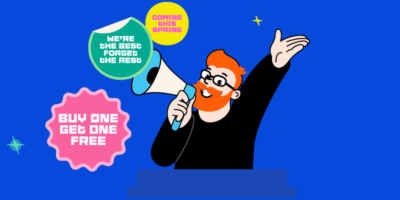To simplify matters, here are 18 common types of marketing that have been developed, tried, and tested by generations of marketers from various industries.
You can find examples of all 18 types around you. They are constantly copied and “remixed” to win the customers’ hearts. Somewhere in this list could even lie the marketing success of the next world-changing company.
Each of them is different, but most can be used in parallel to form a bulletproof growth engine.
But first, let’s answer the fundamental question of…
Marketing is the process of creating desirable products or services and distributing them in a way that increases their attractiveness.
Digital marketing is an overarching term for any kind of promotional activity that leverages the internet as the messaging channel. Accordingly, even two different marketing tactics, like SEO and PPC, are considered digital marketing.
This term is often used to differentiate a category of tactics from offline marketing.
Example
At Ahrefs, we use various digital marketing tactics and tools to share our expertise in SEO and marketing and promote our product.
Often, a particular topic, such as an SEO checklist, will be used in a blog post, then repurposed on other platforms and promoted through different channels; all of that is digital marketing.

Here’s a tweet featuring the SEO checklist compressed into one infographic.
Looking for a complete SEO checklist for 2021?
— Ahrefs (@ahrefs) August 15, 2021
Here’s one you can follow. pic.twitter.com/65brjXPBcg
We’ve also promoted the checklist through online advertising. This example is from Quora Ads:

And here’s our Weekly Digest newsletter promoting the original post:

In contrast to digital marketing, offline marketing (often referred to as traditional marketing) is an overarching term for any kind of marketing done without the use of the internet.
If an advertisement is published in a paper magazine instead of an online magazine, that’s offline marketing. Similarly, if you deliver a personalized message through direct mail instead of an email, that’s also offline marketing.
Although words like “offline” and “traditional” may give the impression that this type of marketing is a thing of the past, advertisements in printed magazines or between TV shows haven’t disappeared just yet.
According to Statista, TV ads still have the strongest reach among all types of ads.

Example
Between 1999 and 2002, Anheuser-Busch brewing company promoted its Budweiser beer with a TV ad that became a popular culture phenomenon.
The “Whassup?” campaign won many advertising awards, including the Cannes Grand Prix, and helped the company increase sales from 2.4 million barrels to 99.2 million barrels in 2020.
Inbound marketing is a marketing strategy that aims to “pull customers in” with relevant and useful content.
To better understand this term, let’s compare it to outbound marketing.
While outbound marketing tries to reach the customer with a message that “interrupts” (e.g., TV ads, PPC, billboards), inbound marketing hopes to create a situation where a potential customer discovers a company while looking for a solution.
For example, a customer searches for something on Google and stumbles upon a relevant article on a company’s website.
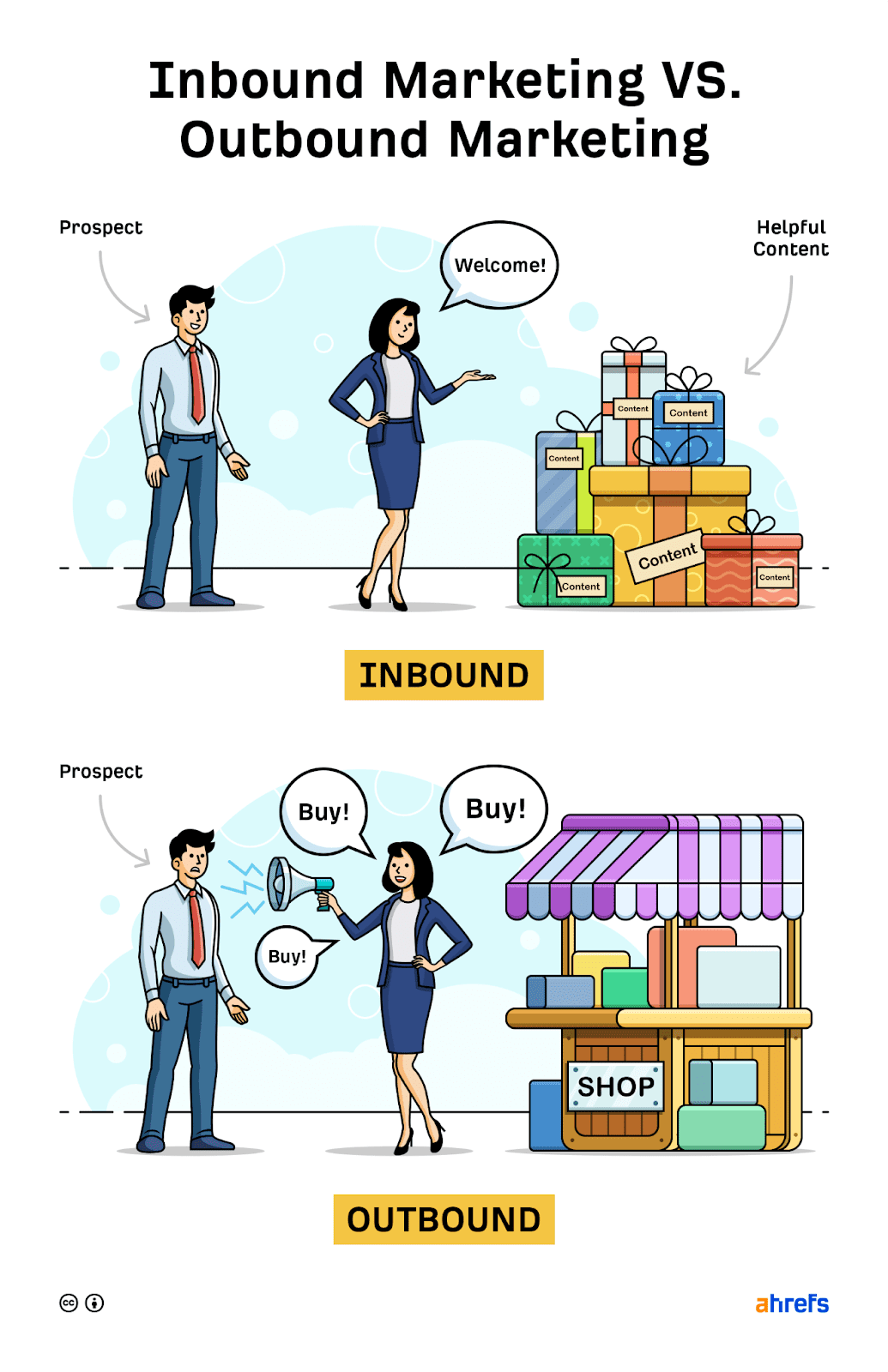
Example
Ahrefs’ free tools, such as the free backlink checker, are designed as a form of inbound marketing.
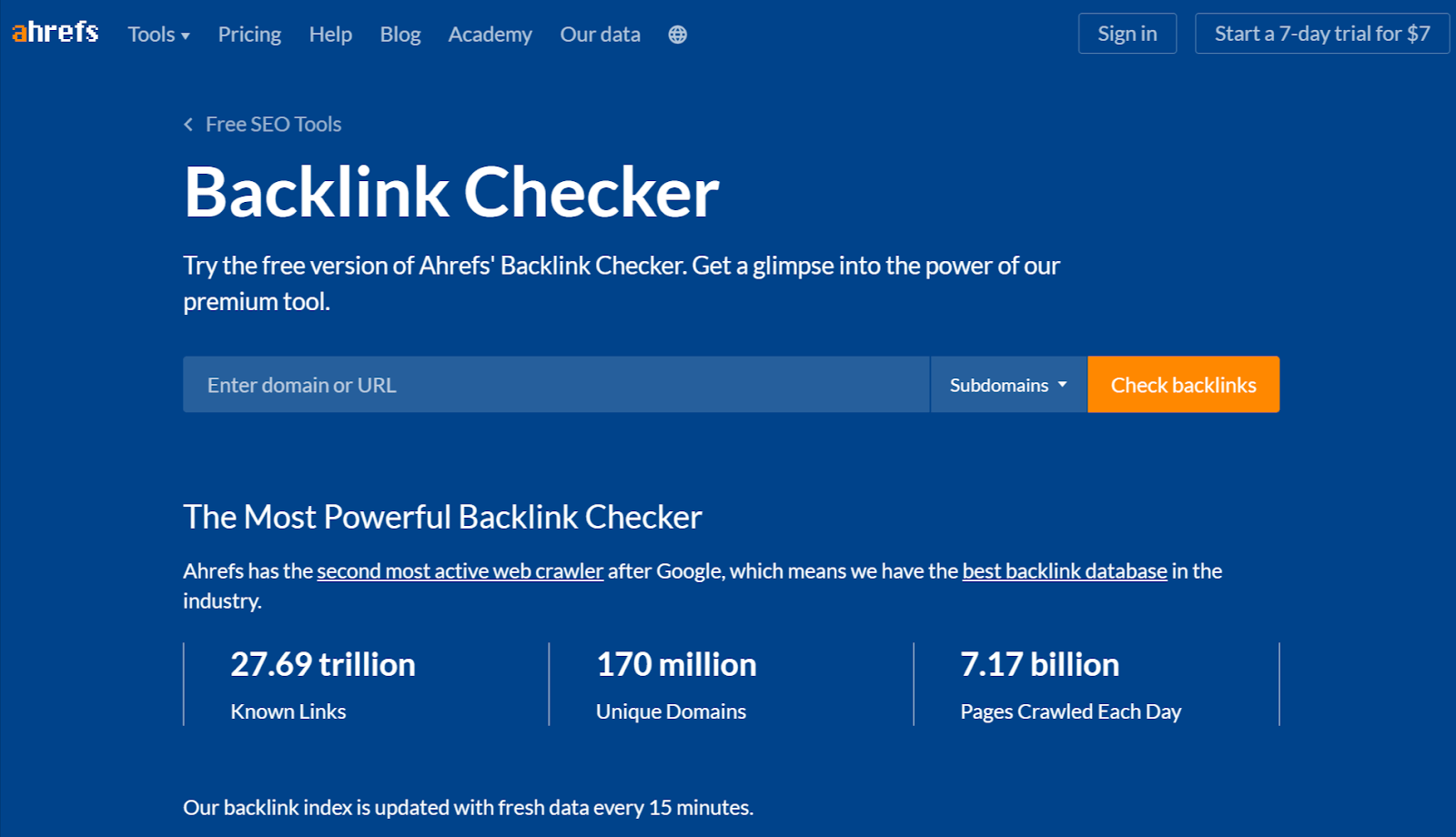
They pull customers from search engine result pages (SERPs) for queries like “backlink checker” or “analyze backlinks.” If the search demand is high, this type of free tool can bring a significant amount of organic traffic:
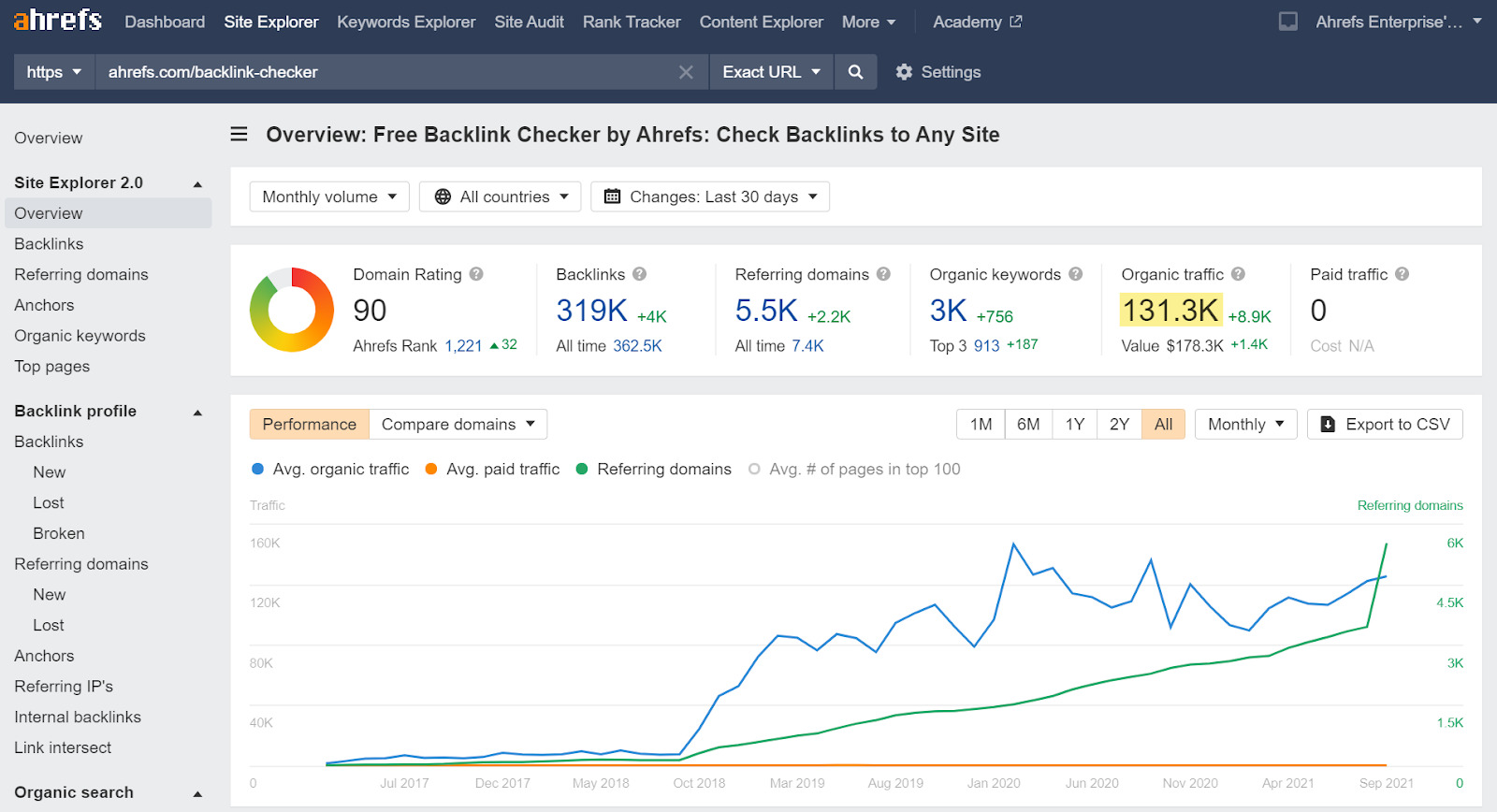
Outbound marketing is an “interruptive” form of marketing where a company pushes a message about a product out to a prospect through cold calls, cold emails, direct mail, most forms of advertising, etc.
Outbound marketing tries to raise awareness of a product or inspire actions (e.g., buying, subscribing, visiting a shop) among the target audience regardless of their interest.
Example
Places like Times Square in New York are examples of outbound marketing reaching its peak, both in terms of the space used to get the message across and the budget needed to broadcast it. Some of what you can see in the picture below is outbound marketing through billboards.

Content marketing is the process of creating and distributing content to attract and retain customers.
Content marketing is usually practiced as a form of inbound marketing, where the content offers a solution to a problem that a prospect is researching. Prospects discover promoted products by learning about their applications.
Content marketing is often used to generate leads, where the most premium content is gated behind a form requesting personal information like name, phone number, or email. Later on, that information is used for other marketing tactics (including outbound).
Example
Some popular types of content marketing are:
- Blog articles
- Videos and vlogs
- Podcasts
- Webinars
- Case studies
- eBooks
- White papers
Here’s an example of how some can be used in a coherent content marketing strategy:
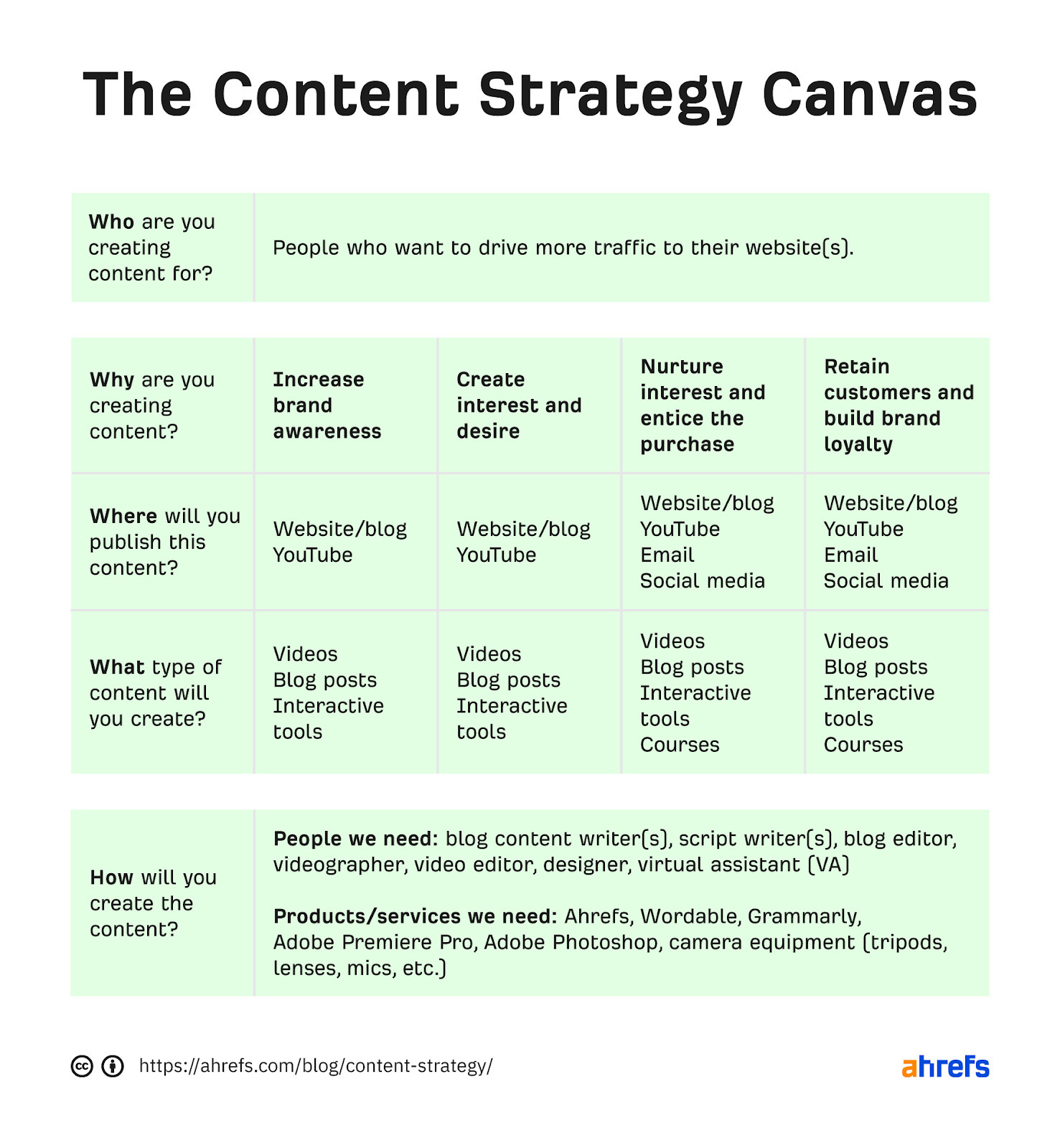
Search engine marketing is a term used to describe promotion messaging published through SERPs. SEM divides the messaging into two categories: paid results and organic results.
Organic results are pages that a search engine like Google finds, crawls, and indexes on its SERPs. The position on organic results can’t be bought, only influenced through content marketing and SEO.
Paid results are a form of pay-per-click advertising. Businesses pay search engine companies to take part in a bid competing for the best ad placement.

Example
Let’s say you want to rank on the first page of Google for the keyword “marketing automation” in the U.S. You have two options to do this: One is through paid results, and the other is through organic results.
A paid result will be one of these:
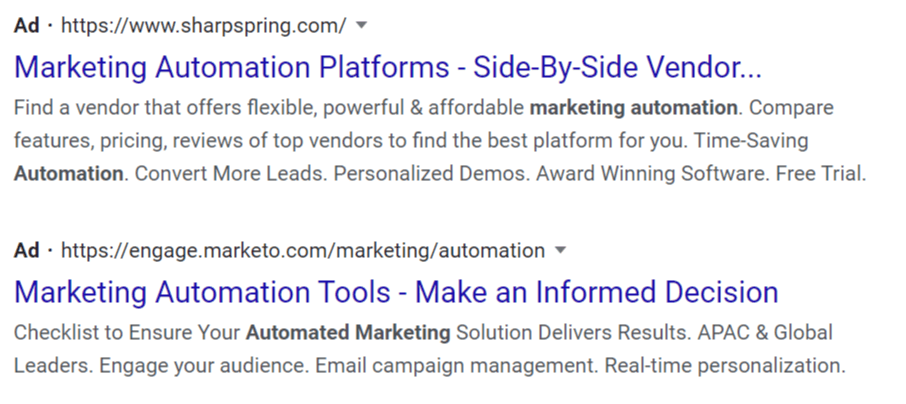
And an organic result will look something like these:
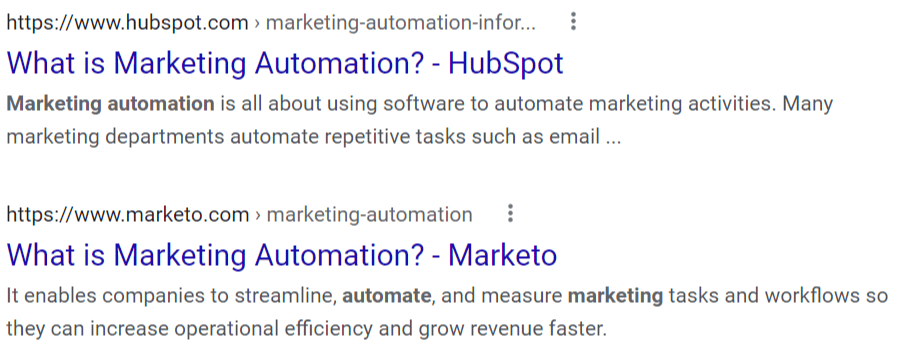
As you can see, they look similar (and fit what Google wants). The main difference is it will cost the advertiser around $50 per click to be included among the big players in the ad space.
To be included in the non-paid, organic space, the advertiser has to create relevant content that matches the search intent and build a lot of backlinks.
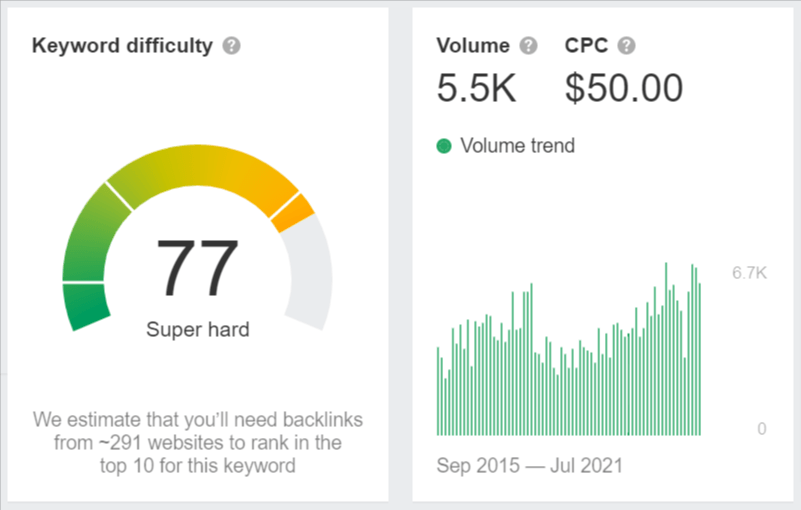
Growth marketing is the process of increasing a company’s revenue by applying an experiment-driven and integrated approach to all stages of attracting customers.
Growth marketing is another term that is often used in contrast to “traditional marketing.” This is because when growth marketing entered the stage in the early 2000s, it was quickly adopted by startups that needed a different approach that helped them:
A. Compete with established companies.
B. Get investors’ attention by proving scalable growth tactics.
The table below explains the differences between growth marketing, “traditional marketing,” and growth hacking.
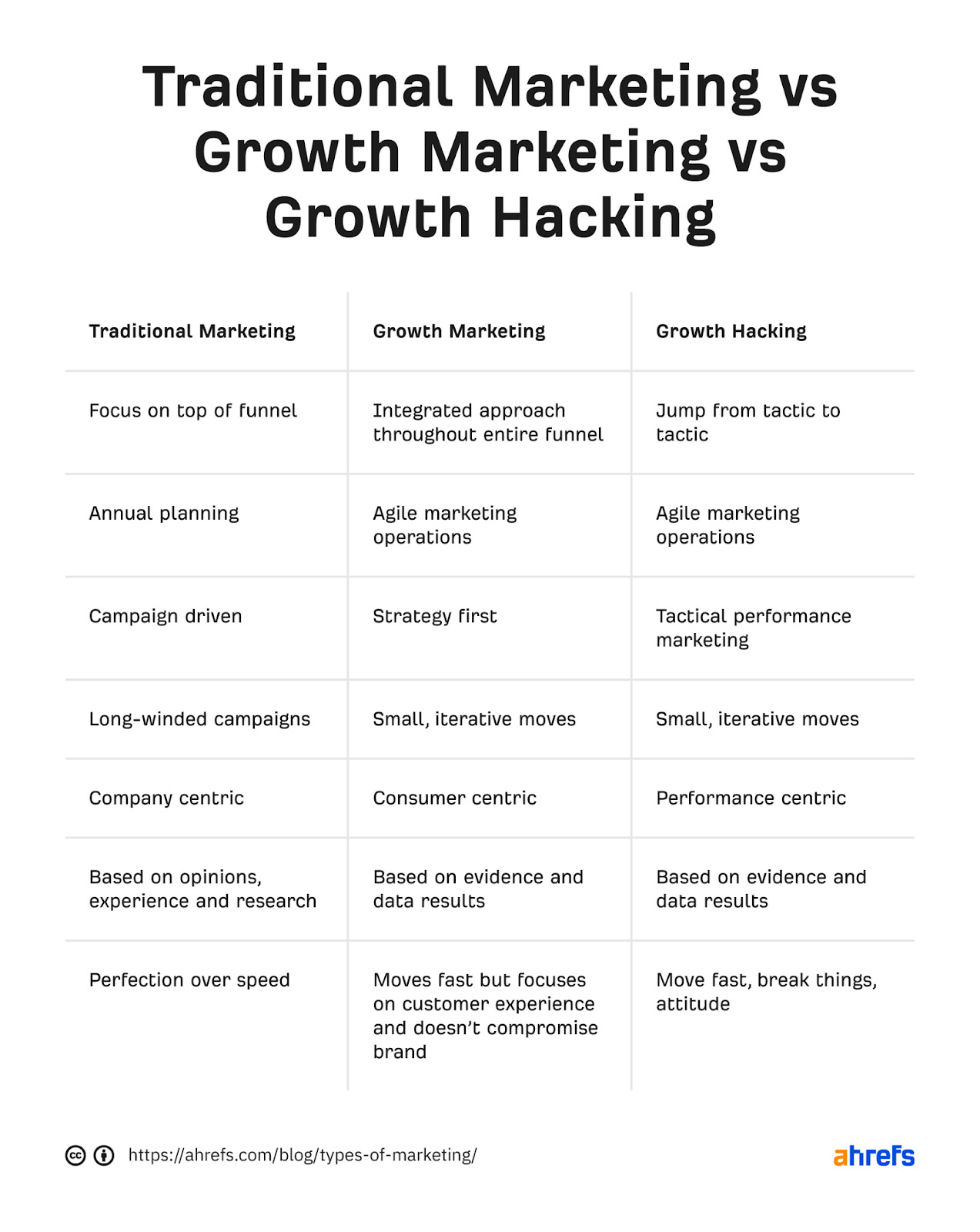
Example
There are many amazing and inspirational modern growth stories: Slack, Spotify, Uber, or Square.
But I want to point you in the direction of Notion’s growth marketing strategy because it seems to get nearly every aspect of growth marketing right. Plus, it’s been analyzed dozens of times, so it makes a great example for entrepreneurs and marketers to learn from.
Notion’s success relies on many pillars: great product, huge and vocal community, and the “freemium” model.
It does growth marketing, but it’s not some black hat growth hacking. It’s growing fast, but its strategy is customer-centric, doesn’t compromise the brand, and aims for the long term.
Many also emphasize the role of user-generated templates in Notion’s success. The company encourages the creation and sharing of usable templates for various documents and operations.
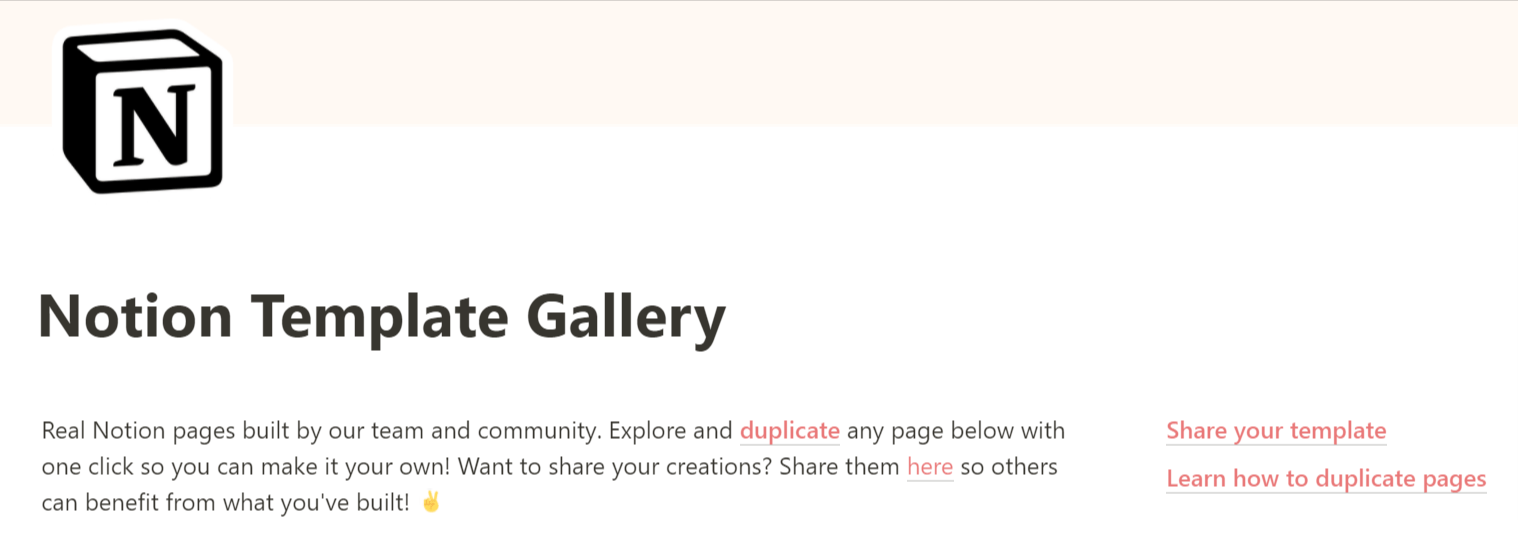
Notion’s users create templates that attract, engage, and retain other users. Many of those new users will then create and share their own templates, continuing the cycle.
Here’s a graphic from Foundation that perfectly explains how this tactic touches the entire marketing funnel and forms a growth loop.
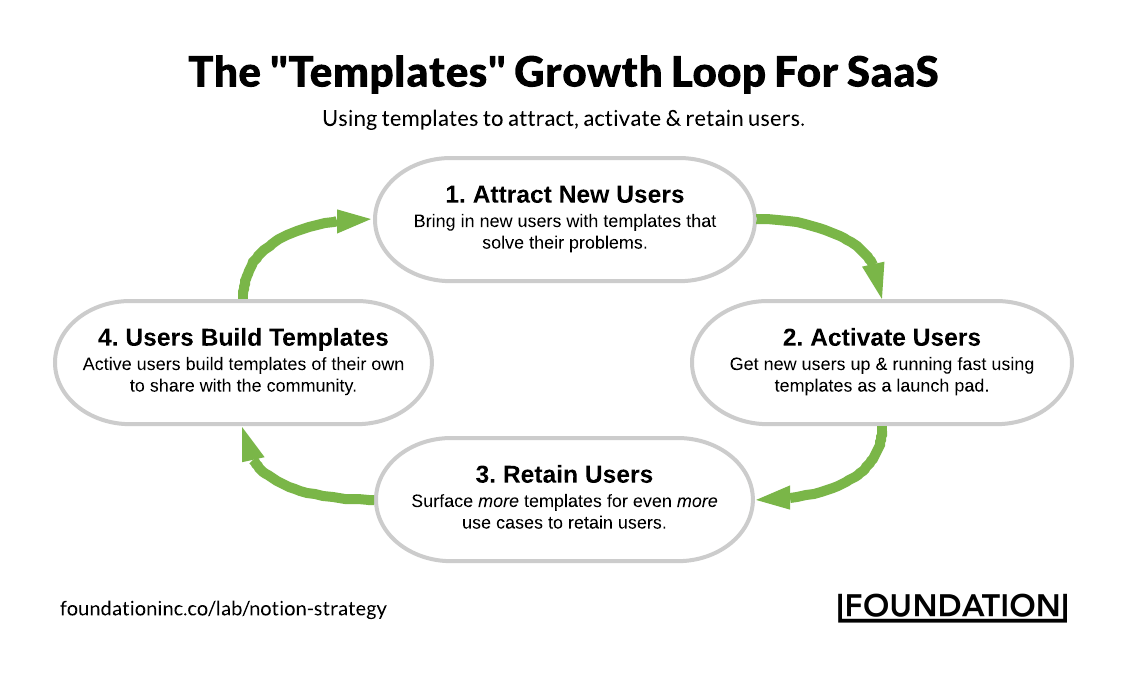
Learn more: What Is Growth Marketing? A Beginner’s Guide
B2B marketing, or business-to-business marketing, refers to the marketing of products or services by businesses to other businesses.
This term is often used by marketers to name and differentiate types of marketing strategies and tactics that are especially effective in B2B relations (e.g., account-based marketing), as opposed to business-to-consumer (B2C) relations.
Example
Businesses like to advertise on LinkedIn. Reason: Its users go to the platform for work-related purposes. LinkedIn takes advantage of that (by design) and offers an assortment of advertising products.
By far, LinkedIn holds a third of all U.S. B2B digital display ad revenue. As you can see below, even giants like IBM use LinkedIn ads to attract customers.
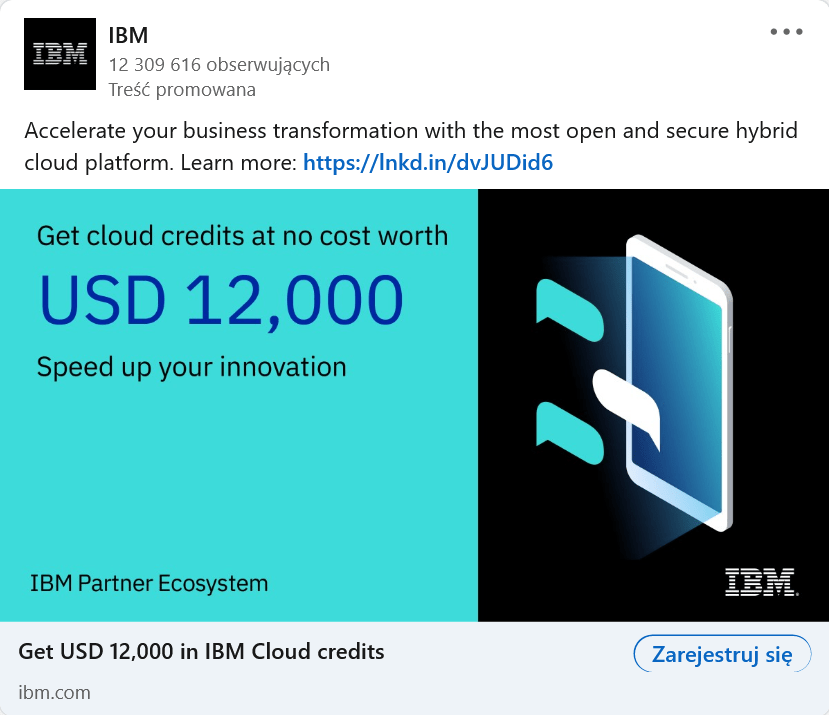
This B2B ad points to a lead-capturing form offering free credits in IBM Cloud’s service.
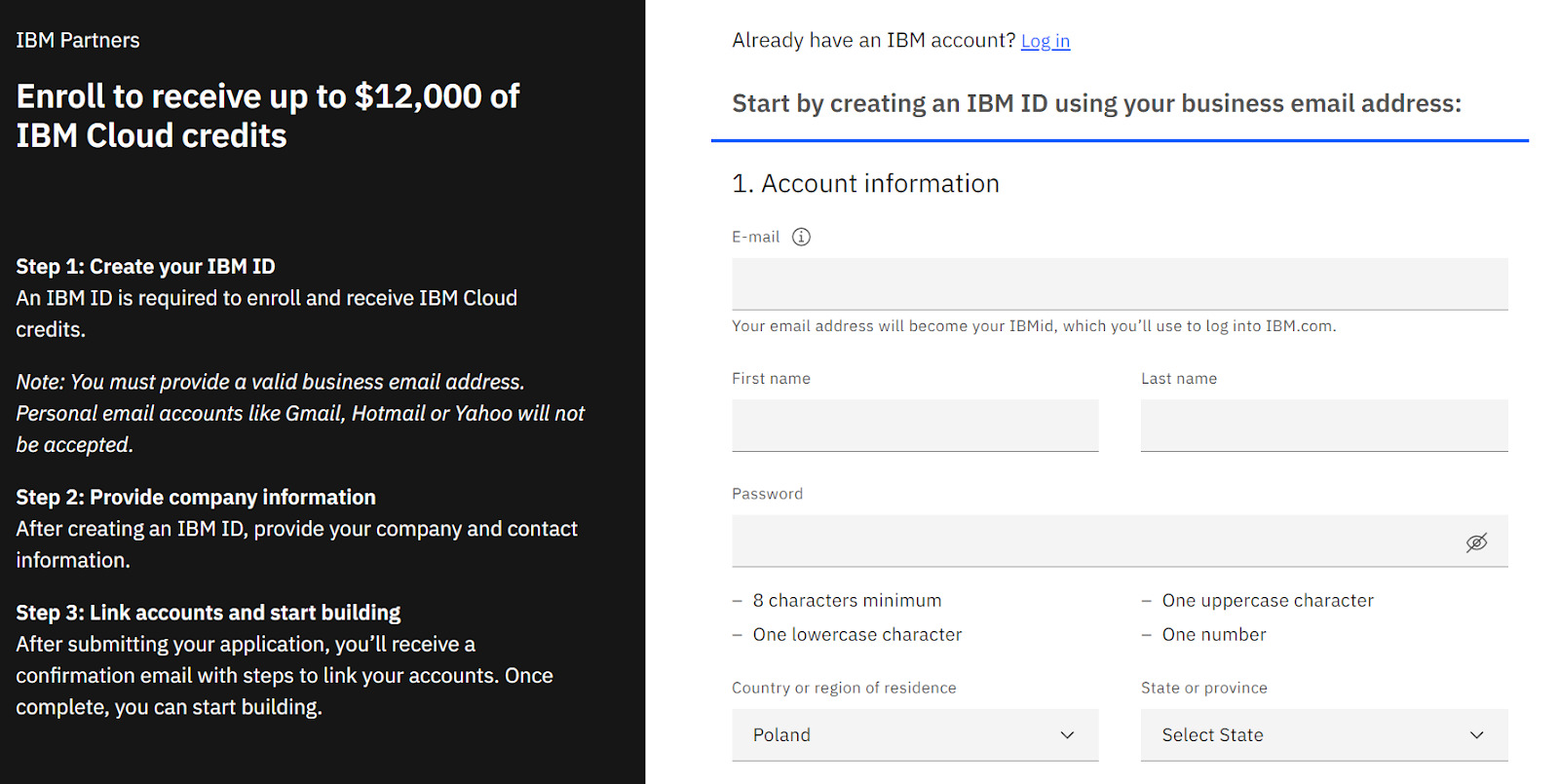
B2C marketing, or business-to-consumer marketing, refers to the marketing of products or services by businesses to consumers.
This term is often used by marketers to name and differentiate types of marketing strategies and tactics that are especially effective in B2C relations (e.g., influencer marketing), as opposed to B2B relations.
Example
B2C marketing is everywhere. I don’t even need to link to a study that will prove how much we are bombarded with ads. You just need to look around you.
All of the stuff that you own was bought because of B2C marketing. Meaning, either you saw some form of B2C promotion that convinced you to make a purchase or someone else did and told you how great that product was.
Let me start this auto-therapeutic exercise with myself.
One day, I was just minding my own business. Suddenly, I got an email from Vans saying that it had this huge sale of its outlet inventory. OK, Vans. I’ll click.
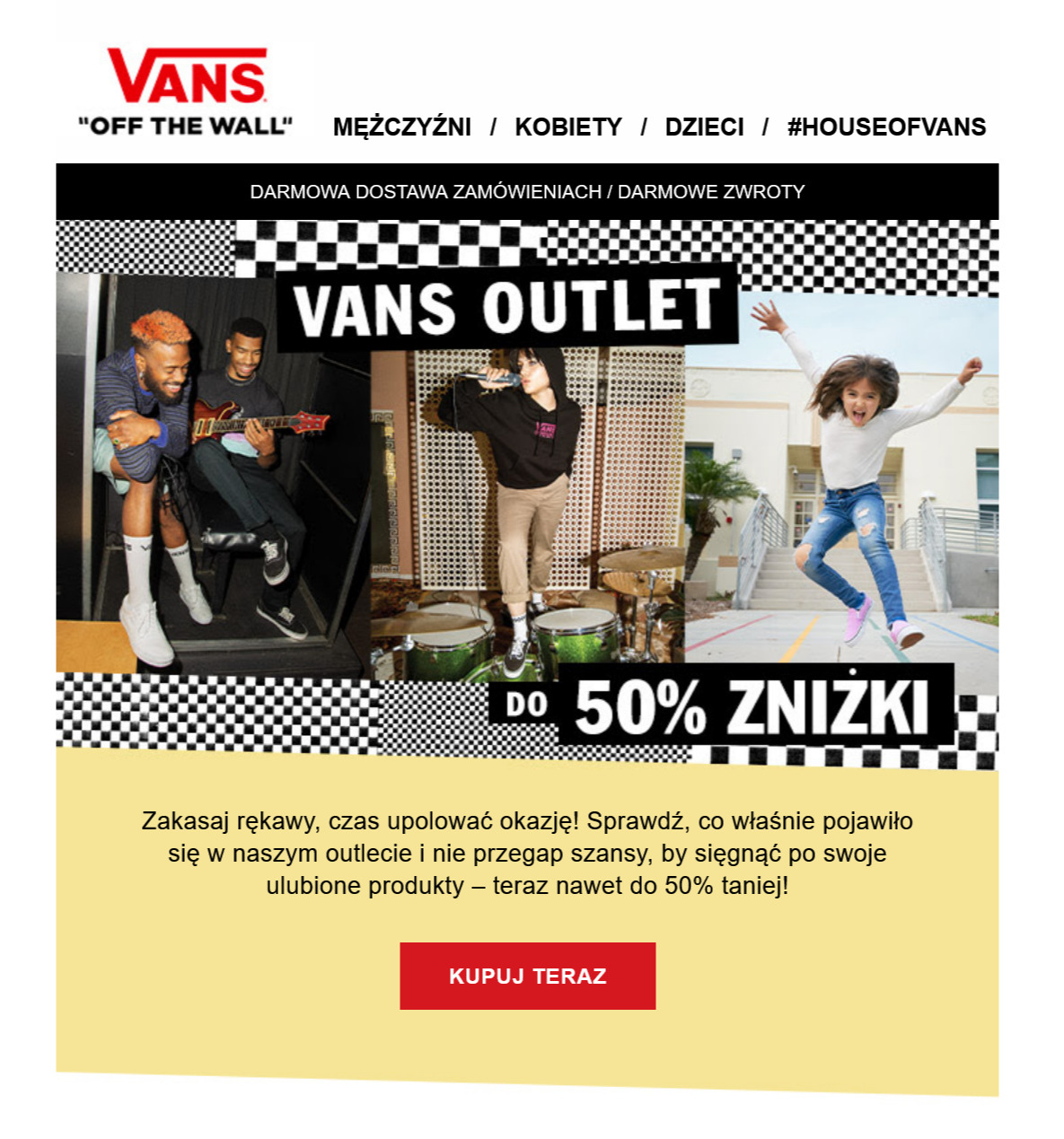
That email (it’s in Polish) led to this landing page, where I saw these shoes.
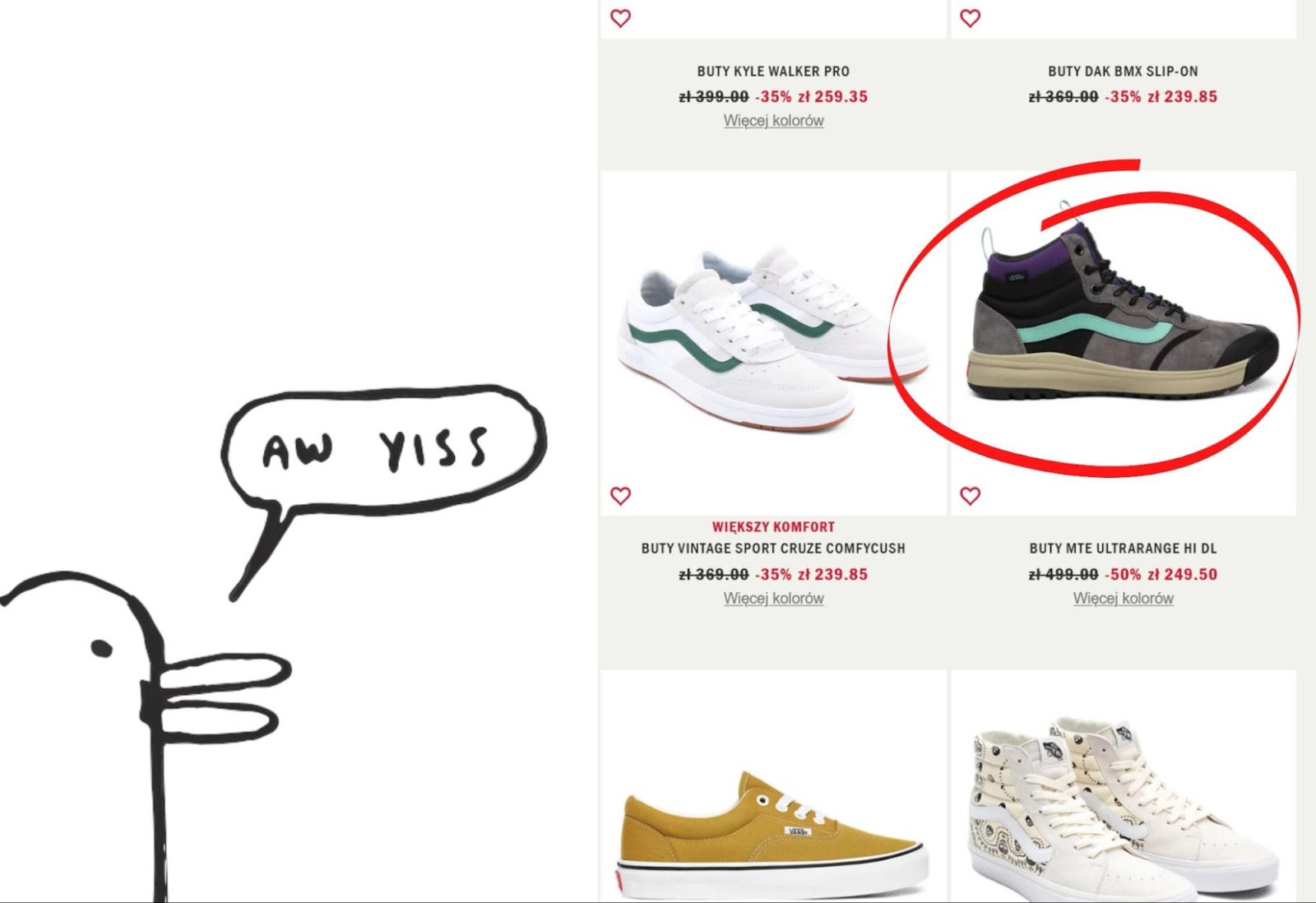
It was exactly what I needed this fall. So a few days later, the shoes materialized at my place.

And that’s the short story of how B2C marketing made me buy shoes in seconds. I didn’t even visit the store to try them on. I was doing something completely different and not even thinking about buying shoes.
But not every email can do that. You’re looking at the power of the brand—Vans being one of my favorites.
With emails like these and online shopping opportunities, a brand can capitalize on every other activity it has invested in, making me know, like, and trust it.
Affiliate marketing is a type of promotion where a company pays commission to an external website for traffic or sales generated by it.
You can spot affiliate links mostly on blogs. Those are the links that contain tracking parameters like “tag,” “hop,” or “customid.”

That means the owner of the website receives a commission every time someone clicks that link or buys something via that link. This way, the paying company rewards affiliates for influencing their bottom line.
Example
This cooking blog explains how it increased its food blog income by fivefold in three months, one of the tactics being affiliate marketing.
Someone bought mushroom capsules worth $3,240 on Amazon after clicking a link on the blog. Just like that, the owners got $145 that day, 24 hours after posting an article featuring those mushrooms capsules.

Everyone’s a winner in this story—the producer, the retailer, Amazon, that blog, and the person who bought those capsules (I presume).
There’s another form of affiliate marketing that is sometimes called partner marketing (albeit partner marketing has at least two different meanings).
It’s when solution providers hold a partner program for other companies to drive the demand and adoption of a product or service using the market capabilities of the program attendees.
Here’s how Microsoft pitches its partner program: “The Microsoft Partner Network is a hub of people, resources, and offerings brought together to give you everything you need to build and deliver successful solutions for your customers.”

Social media marketing is the use of social media like Facebook, Twitter, or LinkedIn to market a company’s products or services.
The goal of social media is to grow an audience and engage with them. This leads to increased brand awareness, website traffic and, eventually, sales.
Social media marketing involves a mix of tactics, including publishing content, responding to comments, and running social media advertisements.
Example
Wendy’s Twitter account has become something of a legend. Here’s why:
The story began with epic Twitter roasts that spared no one. It started accidentally with a straightforward answer to a not-too-bright comment from a customer and quickly progressed to the highlight of this Twitter handle.
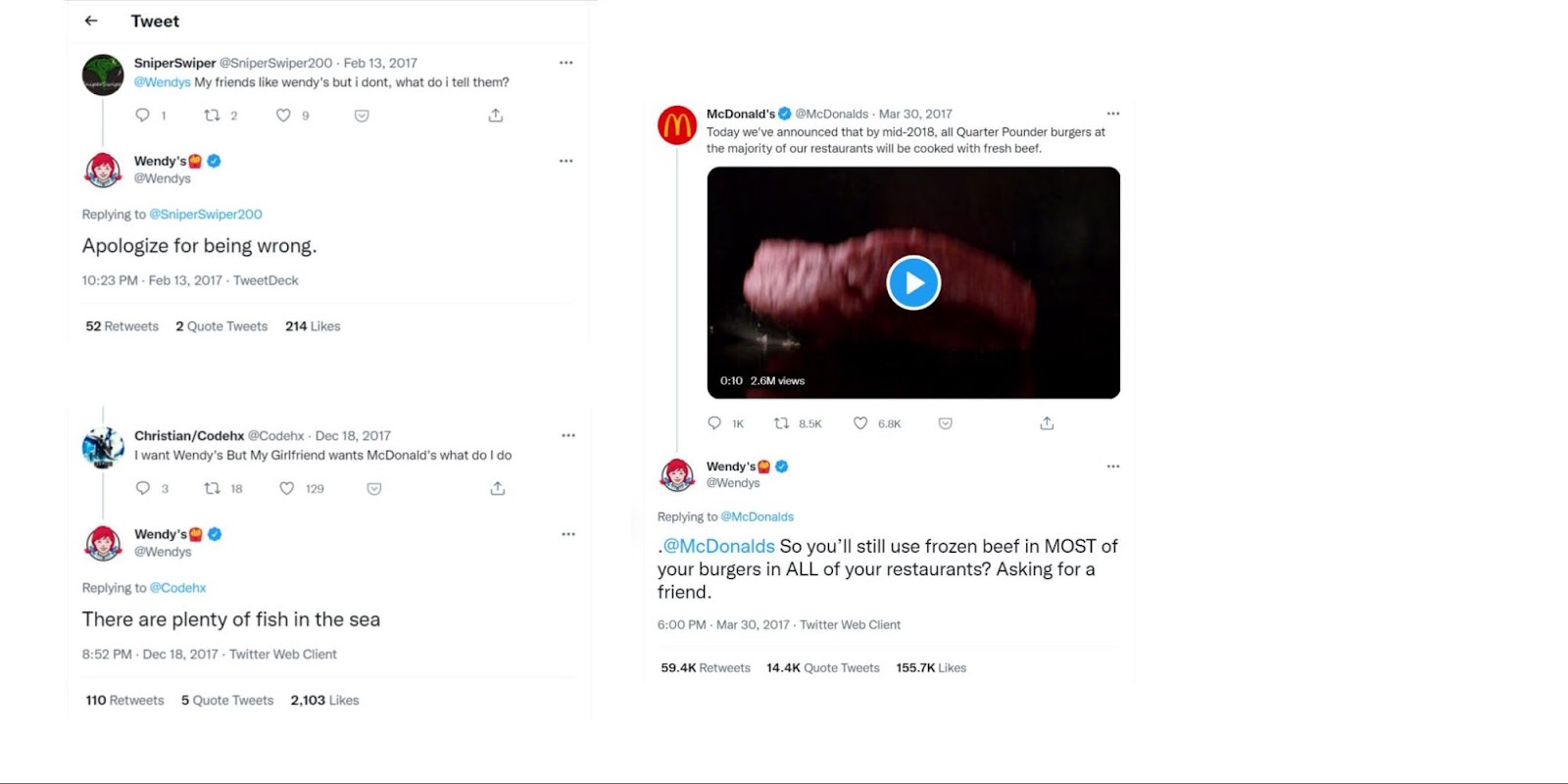
That kind of “brand voice” gave Wendy’s messages a feeling of authenticity that made its competitors sound like heartless corporations.
As more eyes turned to the next thing Wendy’s said, this tweet came along, aka the third most retweeted tweet in history:
HELP ME PLEASE. A MAN NEEDS HIS NUGGS pic.twitter.com/4SrfHmEMo3
— Carter Wilkerson (@carterjwm) April 6, 2017
This man didn’t get those 18 million retweets (only 3.1 million). But Wendy’s hooked him up with a year of free chicken nuggets anyway. Wendy’s proved not only can it get people’s attention, but it can also keep its promise (something fast-food chains are not known for).
There are more amazing Wendy’s social media case studies (see GroupNug or March Madness). But while pushing the boundaries of corporate marketing, Wendy’s doesn’t forget social media is also about customer service or simply promoting its business from time to time.
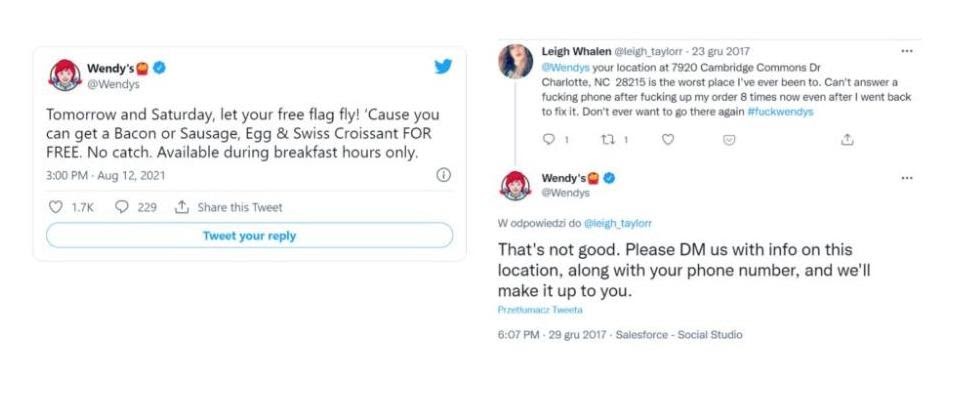
Brand marketing is a term to describe actions that promote a product or service in a way that highlights the brand and shapes its image.
But what is a brand?
In the modern field of marketing, it’s quite hard to give a definition that’s exhaustive and satisfactory. After all, brand marketing is practiced in so many styles.
Let me give you some examples of strong brands. What comes to your mind?
- Apple
- Mastercard
- The Avengers
- BMW
- Coca-Cola
Did those names spark some kind of image in your mind or an association with a person? Maybe it evoked a certain feeling and memory or even made you thirsty. That’s what brands essentially are: cognitive and emotional triggers.
So it’s less important what brands are. Rather, it’s more important what they do. And that is the aim of brand marketing: to strengthen the effect that brands have on consumers and make them:
- Recognize the product (and distinguish it from the rest) – Otherwise, you’d be asking yourself the question, “Is that the delicious chocolate bar I had last time?”
- Associate it with a positive experience – You may not have tried the product. But if the fantasy of you consuming the product gives you a positive feeling, then that’s all it takes.
- Rationalize the cost of the product – BMWs are not the best-built cars in the world. And they are not the cheapest either. Yet, a BMW is still said to be the “ultimate driving machine.”
Consumers are not the only possible targets of brand marketing. Companies may also use this type of marketing to increase their stock market valuation or to attract talent to their company (employer branding).
Example
I have to be honest. I fell in love with this ad right away. It made me want to buy some LEGOs and “rebuild the world.”
The ad shows a little bit of LEGO’s product. But more importantly, it highlights the brand and shapes its image.
I don’t know if you’ll agree with me, but this ad frames LEGOs as positive, non-violent, and cognitively stimulating toys for everyone.
Moreover, this is the toy for the builders of tomorrow. A world built on diversity, respect, and mutual help; a non-zero-sum world.
And it doesn’t matter which LEGO set I’ll buy—they are all like that. And through brand marketing, LEGO managed to get that message across in 60 seconds.
Direct marketing is a strategy where the company directly communicates with the target audience instead of using mass media.
Direct marketing is usually chosen for its lower cost (compared to mass media), the ability to personalize the message, and the possibility of the audience responding to the message (e.g., through an included form).
Example
We all are recipients of direct marketing. The evidence of that is the little metal box next to the mailbox many of us have, designed to keep unwanted flyers and catalogs in one neat place. It can also be seen in the ubiquity of these kinds of signs:
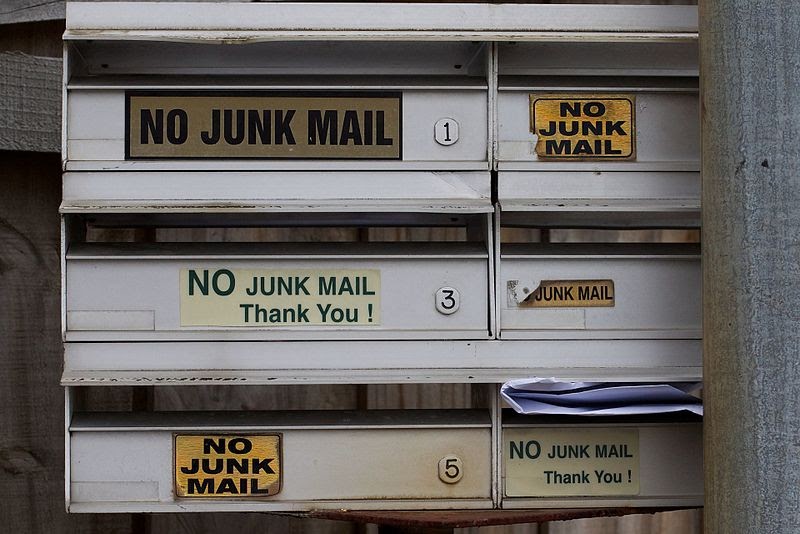
But let me give you a positive and effective example of direct marketing: Ikea’s first few catalogs.
That’s how the business of Ikea started in the first place. Ikea was a little bit different in those days. It didn’t sell mostly furniture; it sold mostly everything.
This is an example of an Ikea mail-order catalog from 1950:

Nowadays, we can just go to the Ikea store and pick something up. Nobody needs to mail us anything. Better yet, we can see the inventory online and make a purchase without leaving the house.
And that was the idea behind the first Ikea catalogs staged in a world without the internet and very few TVs. It was an ingenious solution (but not exactly original) to reach many potential customers and “lower the friction” of purchasing products.
Also, for people living in remote areas of Sweden in those days, the catalogs represented variety and style delivered to their doors.
An influencer in this regard can be anyone with a significant network, or “following,” of people and/or authority in a particular field.
Influence mechanisms leveraged in this type of marketing can take many forms: inspiration, trust, belief, and imitation. Influencer marketing is effective because following others’ examples or advice helps people to make choices.
Moreover, since influence is a phenomenon of human relations, influencer marketing works both in B2B and B2C situations.
Example
Here’s an example of an influencer marketing super-production.
YouTuber Meredith Foster was one of the few carefully selected influencers to promote Motorola’s new smartphone product line.

Meredith’s channel has 4.8 million subscribers. Compare that with the average reach of news programming in the U.S., and it’s easy to see why influencer marketing can be a powerful strategy.
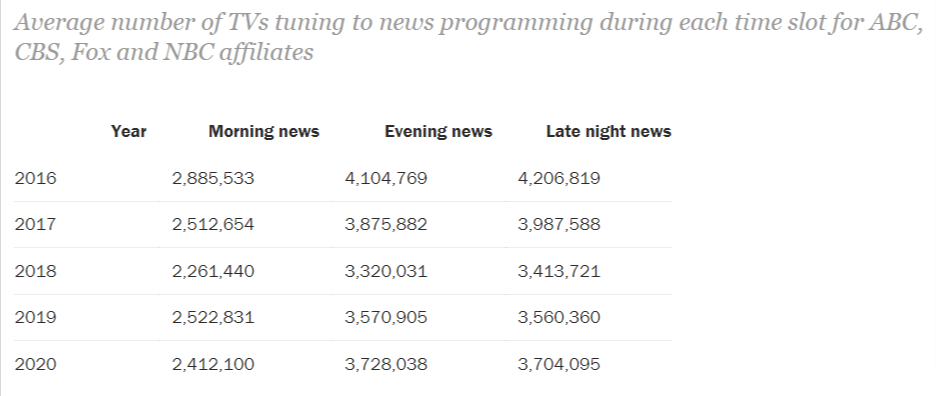
Email marketing is any kind of marketing messaging done through the channel of email.
That said, email marketing is not just sending emails. It involves:
- Building an email list.
- Designing and sending emails to the subscriber list.
- Monitoring the results.
- Curating the email list.
This type of marketing serves four main purposes:
- Generate traffic – You can communicate with your audience through emails with the goal to take them from the email to a specific page, e.g., your latest content.
- Lead nurturing – This includes so-called drip campaigns used methodically email by email and touchpoint by touchpoint, leading email subscribers to a purchase opportunity. This process also “qualifies” leads to different types of subscribers, e.g., potential business opportunities or brand fans.
- Onboarding – This refers to a sequence of emails sent through the “lifecycle” of a customer to make them discover and experience the value of the product and eventually retain them. A common use of email onboarding is within a trial period of a SaaS product.
- Generate revenue – Like Vans did with me. Brands often offer customers an incentive to sign up for a newsletter, such as 20% off the next purchase. Then it’ll send special offers to newsletter subscribers.
Example
Since I’ve shown two examples of emails before, and since you probably get a ton of emails yourself, here’s an illustration of an email marketing workflow.
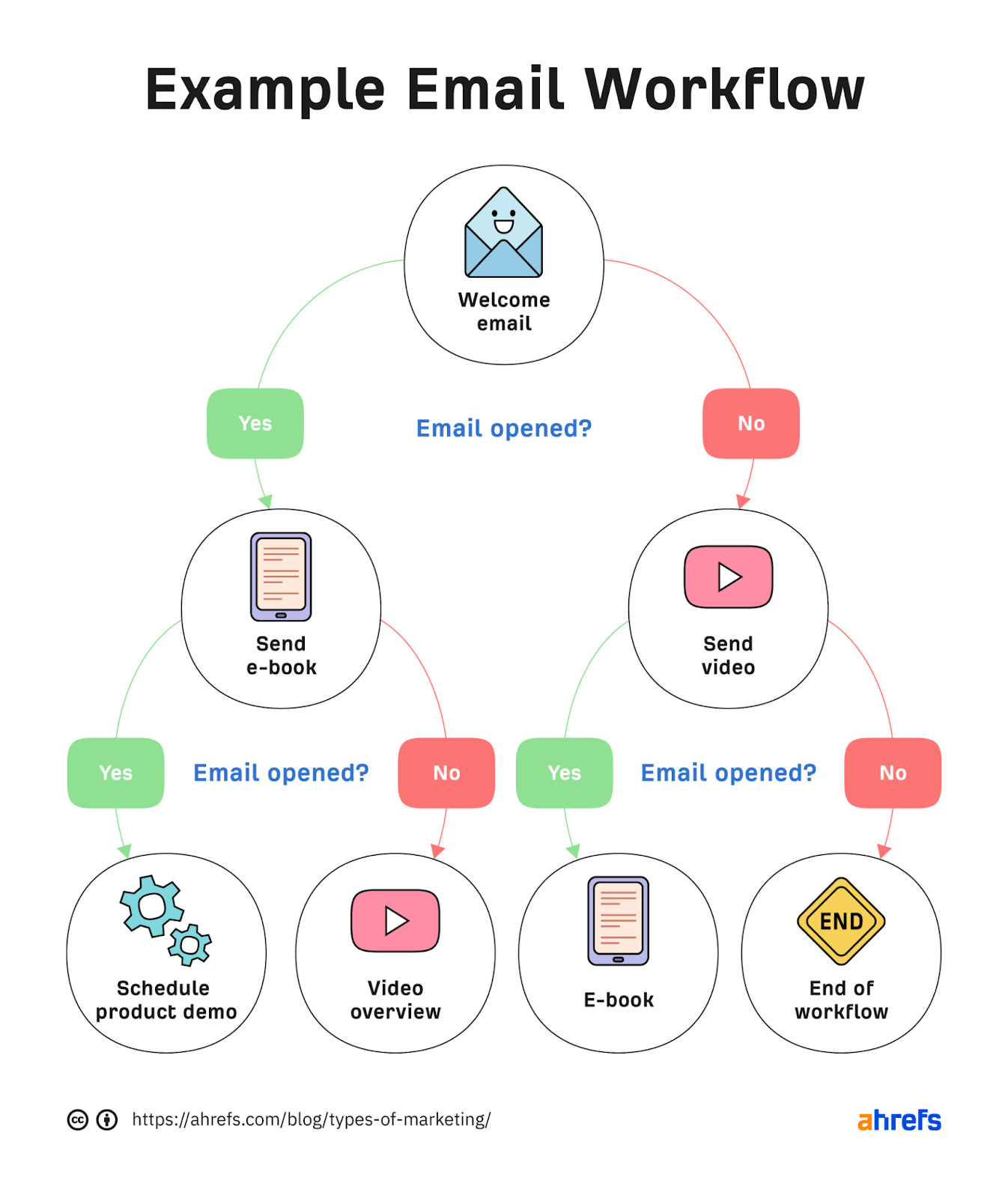
In this simple email drip campaign, recipients are automatically sent emails based on their engagement.
If recipients react positively to the emails, they get more in-depth educational materials and even a product demo.
But if they don’t open the subsequent emails, they are put on a path of less time-consuming educational materials and will eventually be taken off the drip campaign workflow.
This kind of email marketing workflow can be designed through a WYSIWYG (What You See Is What You Get) editor in email marketing tools without coding skills.
Word-of-mouth marketing is the process of influencing and encouraging natural discussions about a product, service, or company.
In everyday use, it can describe two types of situations:
- WOMM as a naturally occurring “side effect” of a company’s operations, such as exceeding consumers’ expectations of a product or service. In such instances, the company may not intend to actively influence the spread of discussions. Yet, the way it’s doing business creates such a strong experience that clients want to share it with friends, family, social media followers, etc.
- WOMM as tactics used to intentionally and actively influence the spread of discussions about the company or its products or services. This kind of WOMM will be the focus of this short chapter.
The essence of WOMM is to give people a reason to talk. The reason why this strategy works is that people often trust what others have to say.
That phenomenon has even been studied:
A Nielsen study from 2015 revealed that 83% of respondents from 60 countries trusted recommendations from friends and family. But when a recommendation came from an opinion posted online, the trust ratio was down to 66%.
According to another study by Brightlocal, 91% of people regularly or occasionally read online reviews, and 84% trust online reviews as much as a personal recommendation.
The aforementioned “reason to talk” doesn’t have to be a recommendation of a company’s services. It can be anything that gives company publicity, creates “buzz,” and increases its brand awareness. For this reason, WOMM is often called “buzz marketing.”
Word-of-mouth marketing can take many forms. It can start as a social media campaign, a PR campaign, or a referral campaign with incentives for spreading the company’s message.
Example
It’s one thing to “earn” word-of-mouth marketing in the form of positive reviews and uninfluenced social media threads. It’s another thing to design and control the whole show.
In “Buzzmarketing: Get People to Talk About Your Stuff,” Mark Hughes describes how he managed to change the name of a town in the U.S. to the name of a startup e-commerce platform he was promoting.
So a town called Halfway was renamed Half.com. For a year. That literally put the new e-commerce platform on the map.

That act was so remarkable that it drew the attention of the Associated Press, Reuters, USA Today, Good Morning America, among others. So imagine how much publicity that e-commerce company got through this single act—all in time for the platform to launch.
In return, the town of Halfway received new computers for the school, a new website, and $110,000.
And six months later, Half.com (the e-commerce) was sold to eBay for $300 million.
Event marketing is a marketing tactic where branded events are used as a way to communicate with the target audience and promote products or services.
The aim of event marketing is to create a memorable experience by engaging event participants, encouraging them to directly interact with a brand.
Interactions may take different forms: trying out a product, watching a product demonstration, watching a concert, attending launches, networking, taking part in a seminar or conference, etc.
Example
Since 2003, Salesforce has organized an annual event called Dreamforce. It brings together “the global Salesforce community for learning, fun, community building, and philanthropy.”
The event is a big, three-day annual pop-up theme park for everything Salesforce. This year, the event was also streamed online.
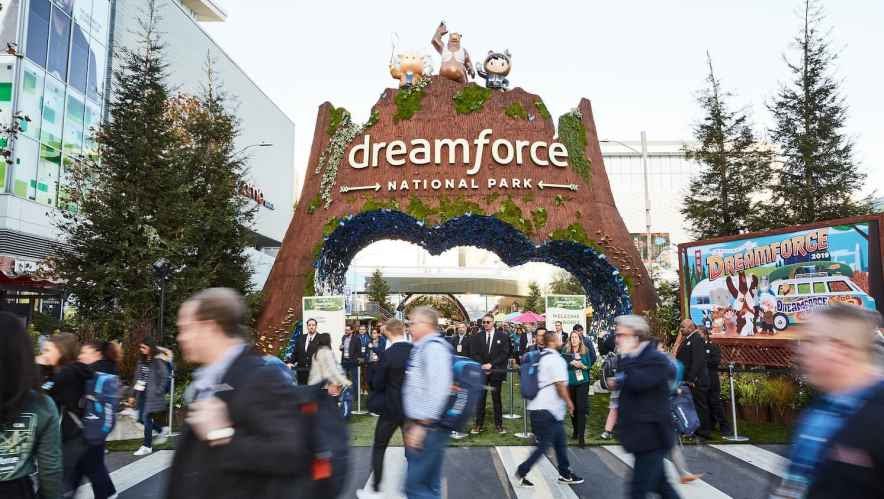
It allows Salesforce to create a multifaceted product experience: Attendees can learn about Salesforce product announcements, discover advanced uses of the CRM, and gain some Salesforce certifications.
But like any theme park, there have to be different kinds of attractions. The event doesn’t just promote Salesforce’s CRM. Dreamforce is an opportunity to listen to talks from celebrities, thought leaders, and politicians. Last but not least, attendees can have some fun at a party.
Join superstar Will Smith at Dreamforce 2021. Together, we’ll be:
— Salesforce (@salesforce) September 22, 2021
1. Chillin’ out.
2. Maxin’.
3. Relaxin’, all cool.
Watch #DF21 on Salesforce+: https://t.co/pXrOL9oVnB pic.twitter.com/qeZSQjQC8v
What’s also interesting about this example of event marketing is it is open to other brands. A whopping 103 other brands help Salesforce make this event possible through sponsorships, scoring their piece of brand awareness.
Guerrilla marketing is a promotion tactic that involves using unexpected and unconventional interactions to evoke strong emotions and provoke word of mouth.
Traits of guerrilla marketing:
- Low cost
- Creative
- Simple and short messages
- Use of public places like streets or shopping malls as a medium of advertisement
- Creates a strong, memorable impression
Example
I believe this example ticks all boxes of exemplary guerrilla marketing.
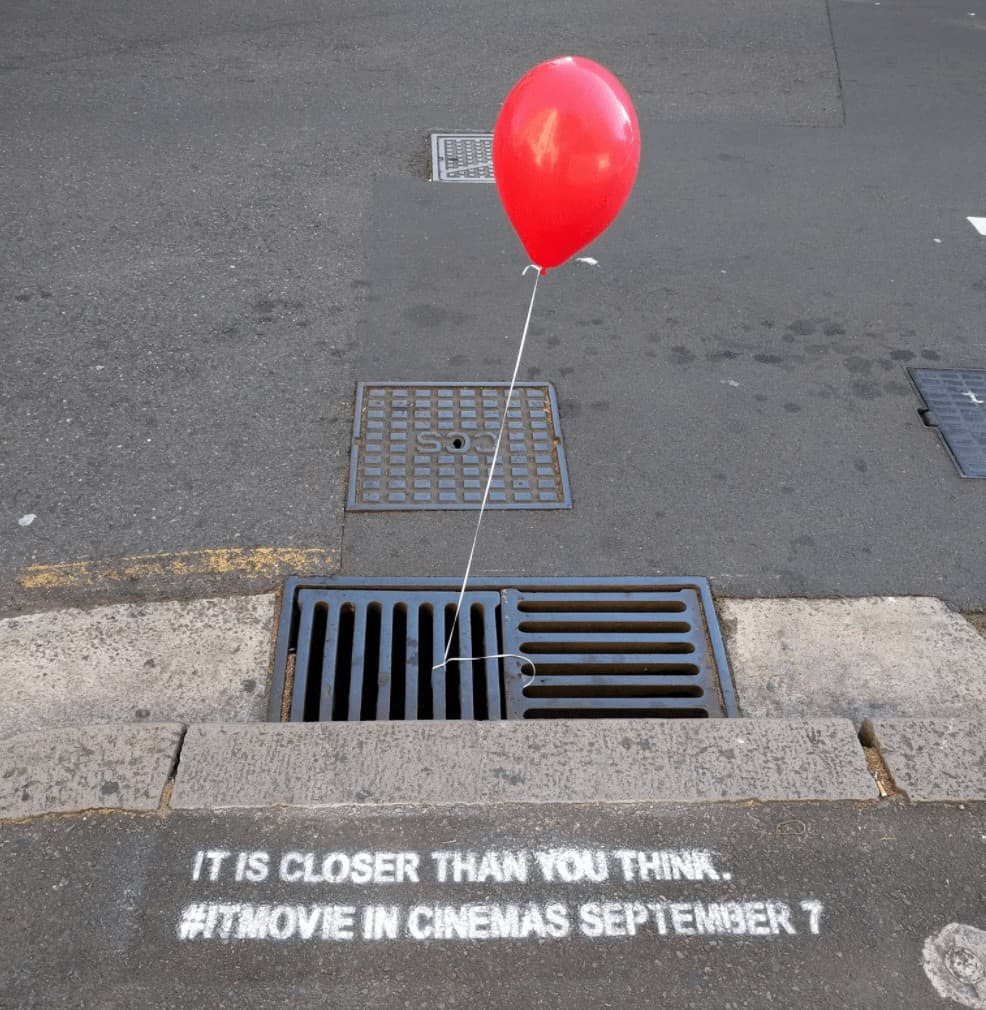
This is one of the many instances of the “IT” movie’s guerrilla promotion campaign. Even if you haven’t heard of the deadly clown from Stephen King’s novel, this sign is so bizarre that it’s guaranteed to make you at least Google the movie.
Moreover, I bet you would tell other people what you saw that day or even tweet about it (I know I would).
https://twitter.com/davepiepers/status/904467548321628160
And if you actually went to see the movie and watched that scene with the balloon coming out of the storm drain, recalling this guerrilla ad would make the movie so much more real and scary.
As for the budget of this campaign, it’s quite obvious. It’s the cost of some balloons, string, and white paint.
Why is marketing important?
There are many good answers to this. But all in all, the importance of marketing comes down to two crucial functions of marketing:
- Marketing makes sure a company develops products that satisfy an existing demand in markets with potential.
- Marketing helps to gain and retain customers through various forms of communication with the target audience (advertising, educational content, PR, etc.).
What is the basis of marketing?
The basis of marketing for any company is the so-called marketing mix. A marketing mix is a system of interconnected elements used to bring products or services to the market and effectively communicate them.
Traditionally, the marketing mix (and hence the basis of marketing) has been defined as the 4 Ps of marketing:
- Product – What you sell.
- Price – How much you sell it for.
- Place – Where you sell it.
- Promotion – How you get customers.
What is a marketing plan?
A marketing plan is a roadmap for executing your marketing strategy over a given period of time, usually a year.
You can create a marketing plan using our simple one-page template.
What is the best type of marketing?
It depends. A marketing type may work for one company but not for another. It’s generally advised to experiment with different marketing types and marketing channels, especially in the early stages of company growth.
What’s more, a combination of marketing types may bring better results than focusing on one type or channel. For example, content marketing works great with search engine marketing (i.e. SEO content).
Final thoughts
With all of those 18 types of marketing, it makes one wonder: Could you just use one type of marketing and stop worrying?
Well, all of the types we’ve discussed were developed for a reason. Some are used to differentiate from competitors and others to accommodate customers’ lifestyles.
The point is you can look at those types of marketing as ready-made solutions for achieving your goal.
Knowing these tried and tested types makes the work of a marketer a little lighter. You can just pick some types from the list and see if they’ll work for your business.
Got questions? Ping me on Twitter.


